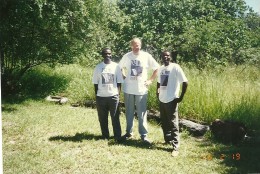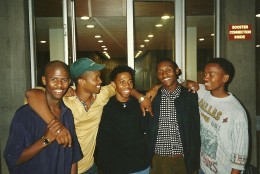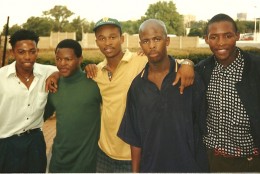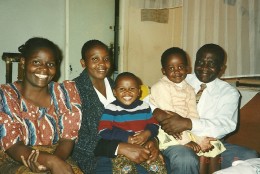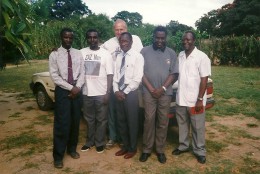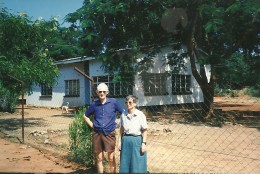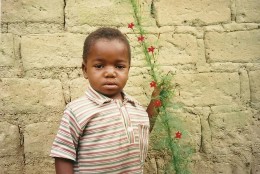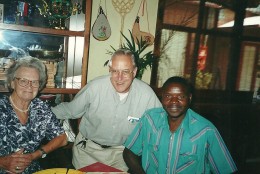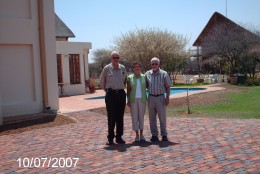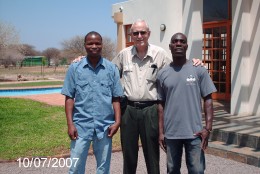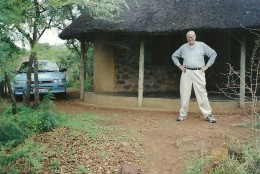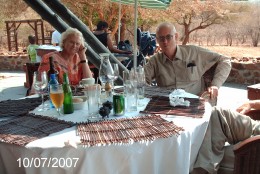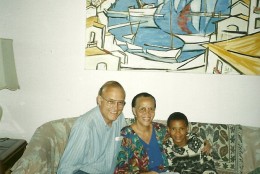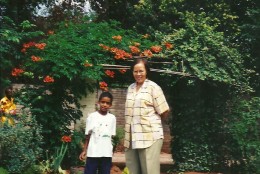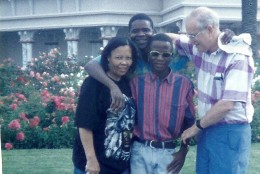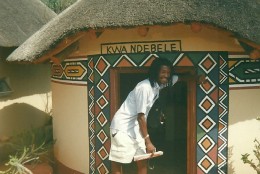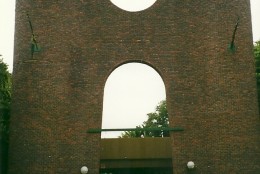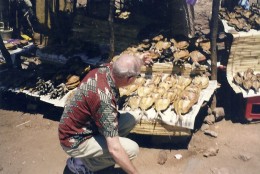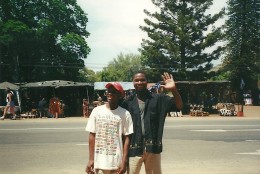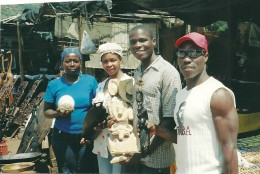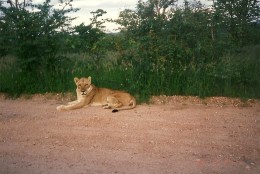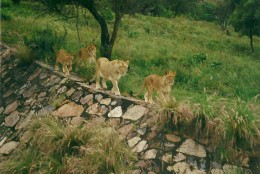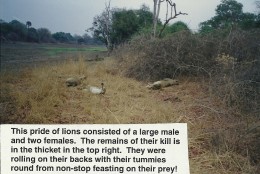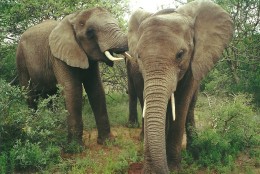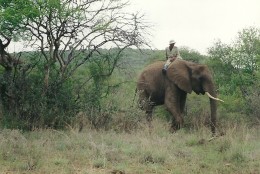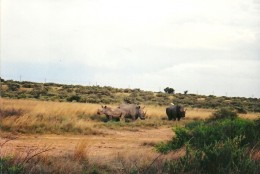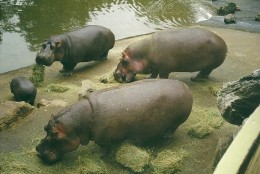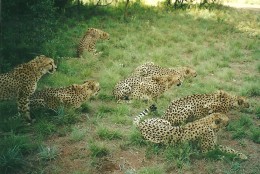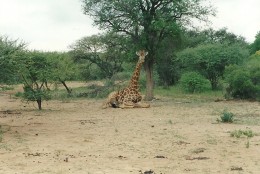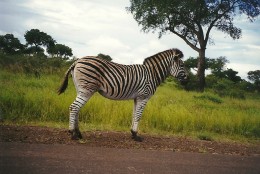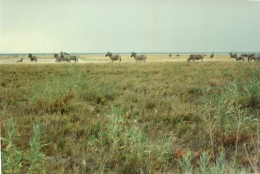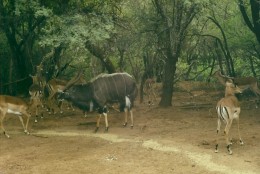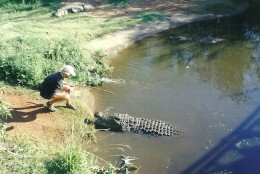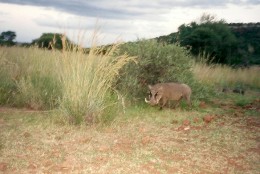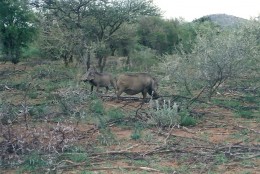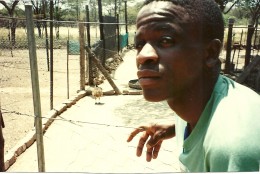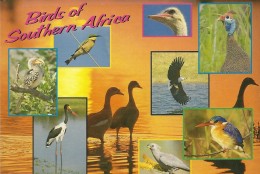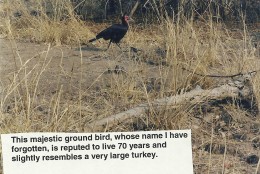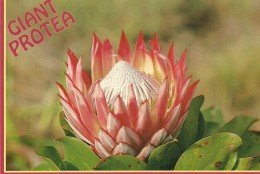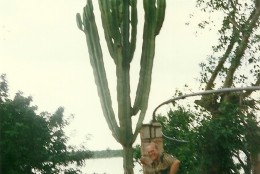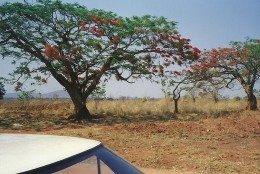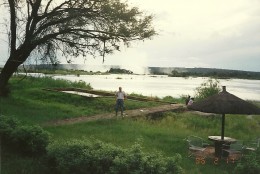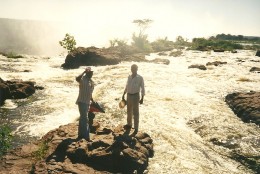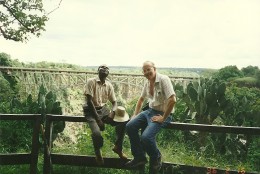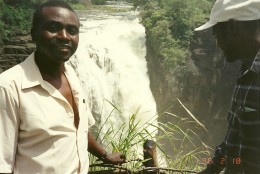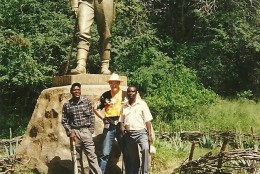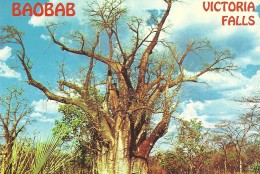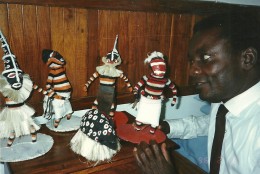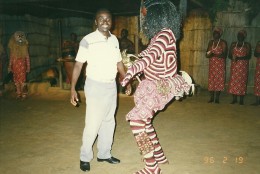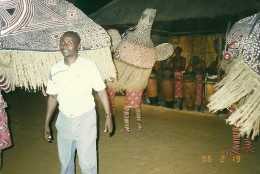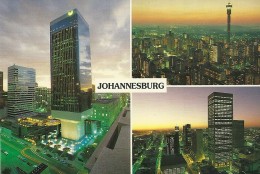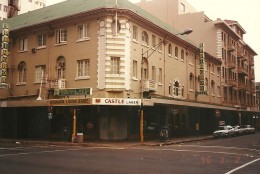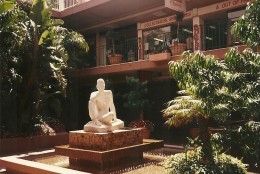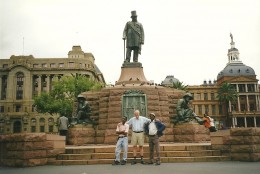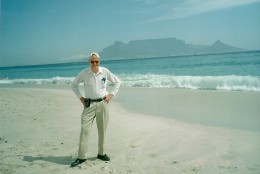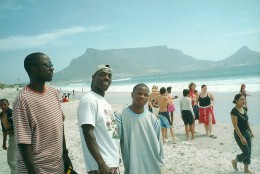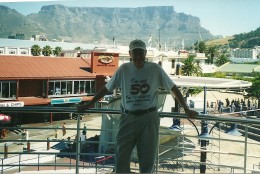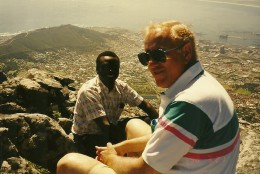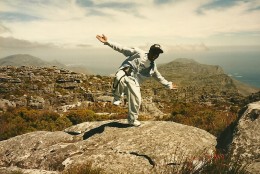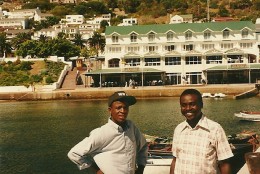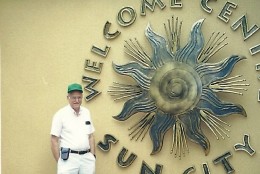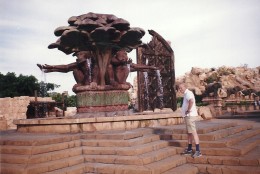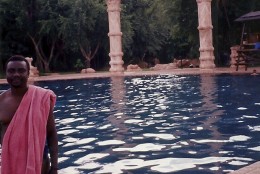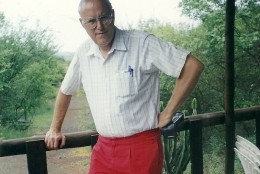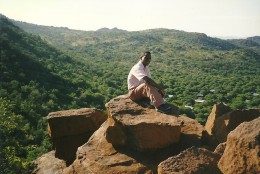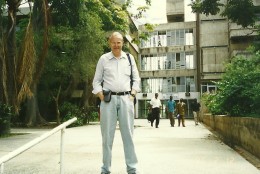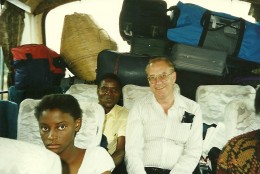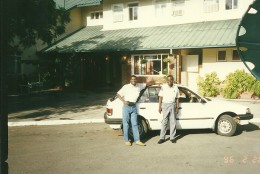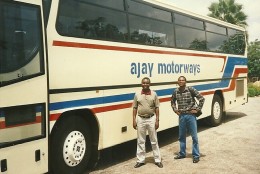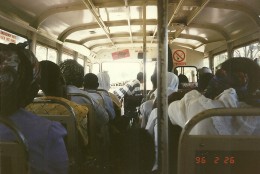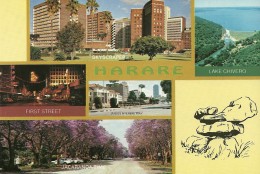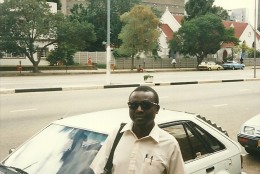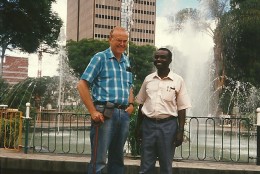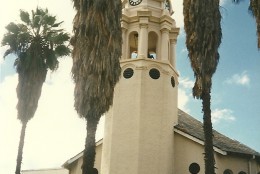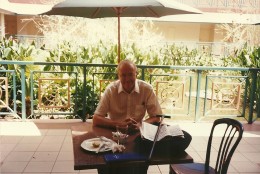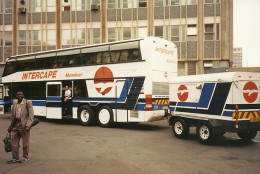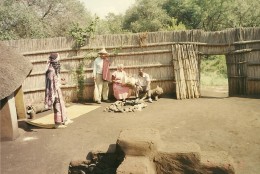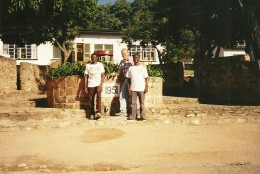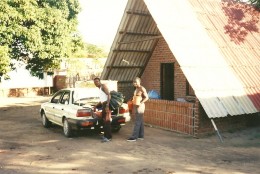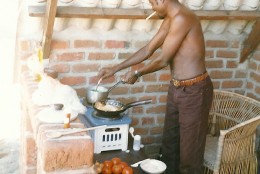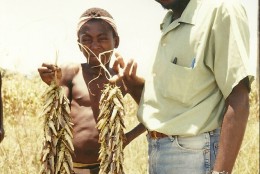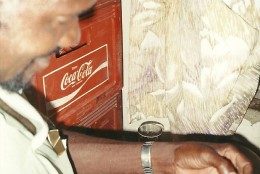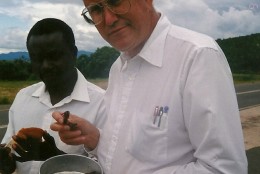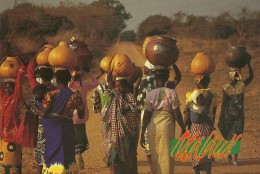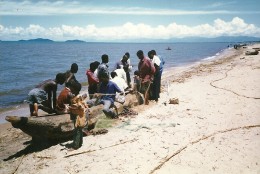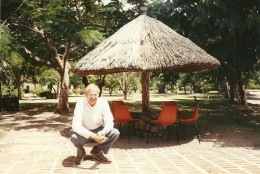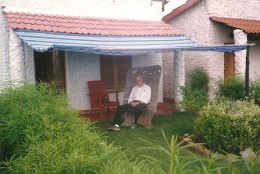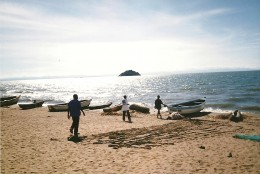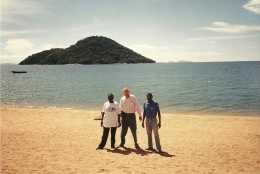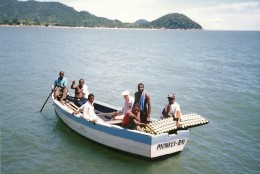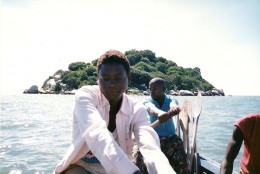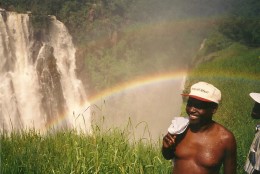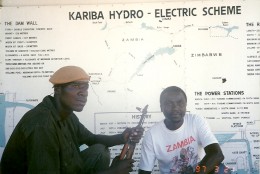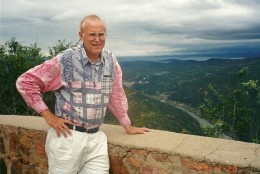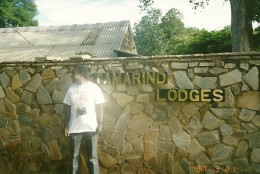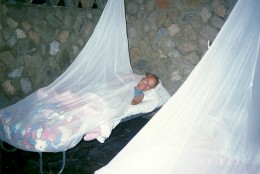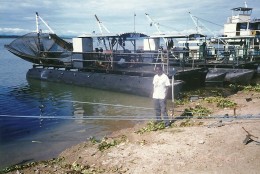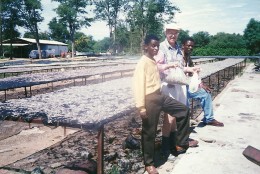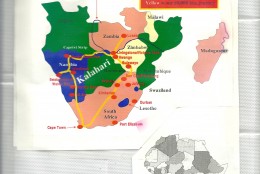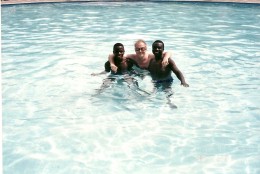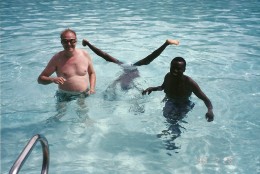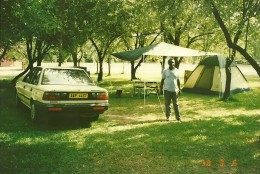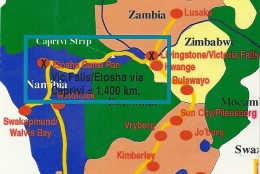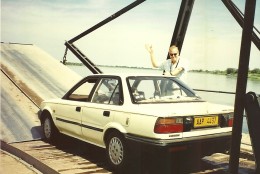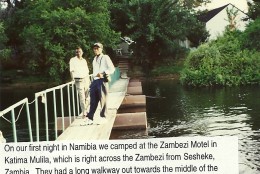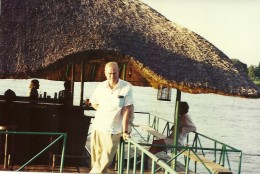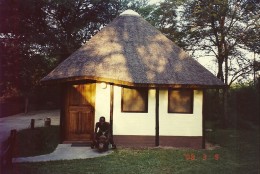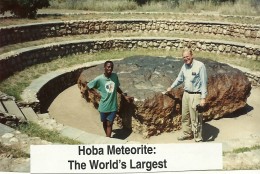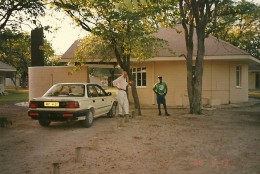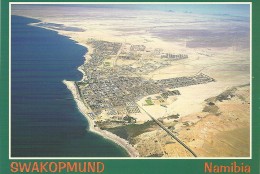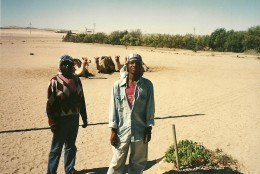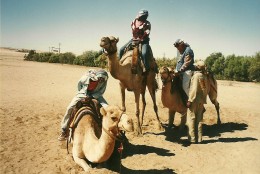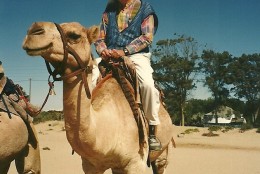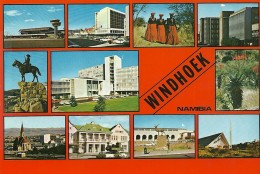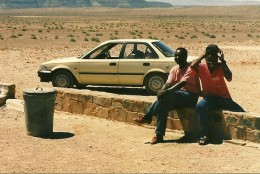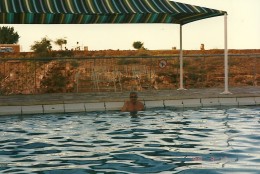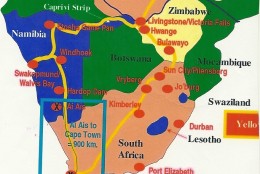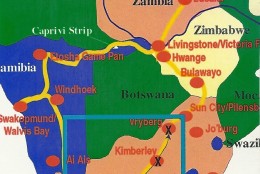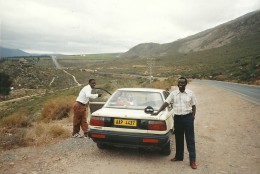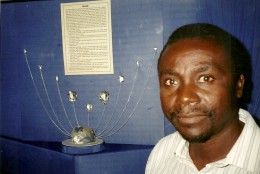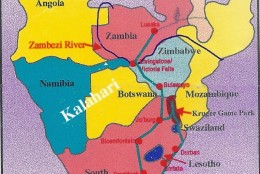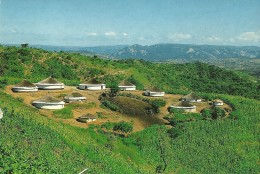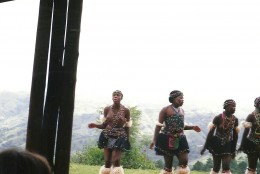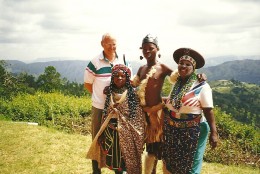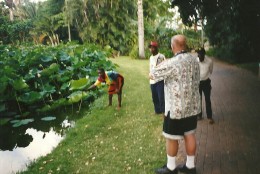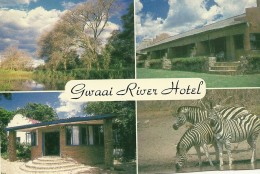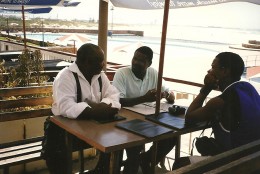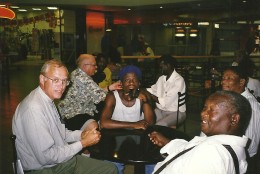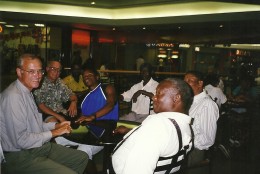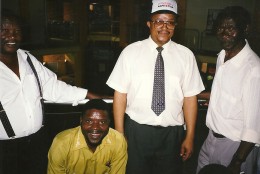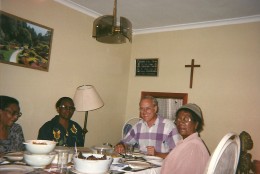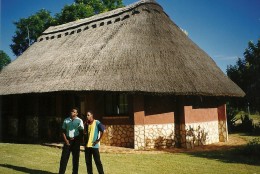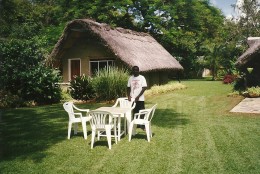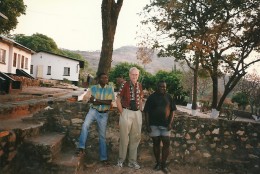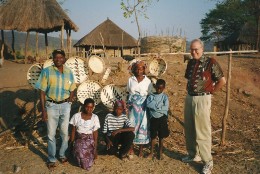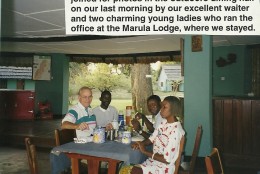African Travels: 1996-2011 — Sixteen trips thru’ southern African
In sixteen extensive trips, I visited much of English-speaking southern Africa but not go to the NWP
These 16 journeys started in early 1996. The first five visits between 1996 and 1999 started and ended in Lusaka and all begin in February and lasted between four and six weeks. Most of the 11 trips thereafter were shorter (ten days to a fortnight) and started and ended in Johannesburg, South Africa, which had became much easier and cheaper. None led me back to the NorthWestern Province again; only as far north and west as Kitwe.
Although all these southern African travels, especially the four longest ones between early 1996 and the end of 1999, were somewhat adventurous, I was always accompanied by friends, many from the NWP, and always felt very safe. I also met friends all along the way on each trip; many who had resettled in South Africa or Botswana from the NWP / Zambia or the USA.
Photographs and chronological narratives. These 16 southern African travels resulted in all the following photographs or photo narratives. First are composite photo collections of friends, southern African fauna and flora and major tourist spots and cities that I saw / visited repeatedly. Then are chronological narratives for the first five “adventurous” trips between early 1996 and late 1999. There are no narratives for the 11 trips between early 2000 and the final trip in 2010. By then I had simply “rested” from adventure and just spent my time re-visiting the same places in Botswana and South Africa, often with the same people. Pictures from these trips appear in my composites of friends, fauna / flora and cities / tourist areas. The order of this very long web page and the numerous photographs is as follows:
- Friends traveled with and met throughout southern Africa on these trips. I rarely was alone.
- Animals and plants — only the most memorable.
- Major tourist spots and cities visited repeatedly with friends, in the following order: Livingstone / Victoria Falls / Hwange Game Park; south African cities: Johannesburg (Jo’burg) / Pretoria / Cape Town; and Gauteng tourist areas of Sun City and a farm camp in the middle that was inexpensive and easy to get to.
- Early 1996 to late 1999. Pictures and narratives of places that I visited only once appear after these composites — in chronological order. These include: Zimbabwe, Malawi, Namibia, Durban and Port Elizabeth.
- 1996 (5th to 3rd March): Jo’burg, Zambia, & Zimbabwe, mostly by bus
- 1997 (4th to 26th March): S.Af., Zambia, Malawi & Zimbabwe by car
- 1998 (23rd to 10th April): “10,000 miles around the Kalahari ” through Namibia and S.Af. (esp. Cape Town) by car. The most interesting trip. Stanley Kamboyi (from Chavuma in the NWP), Alexander Ajibu (from Malawi) and I literally circumnavigated the edges of Kalahari desert.
- 1999 (8th to 22nd March) through Kruger and eastern S.Af. by car
- 1999 (7th to 22nd October) east from Lusaka to Luangwa Game Park
Friends traveled with and met throughout southern Africa.
I rarely was alone. My travel companions were generally between one and four; all that could fit into a Toyota Corolla! Most often, these were: Stanley Kamboyi (an excellent ex-military driver from Zambia), Petulo Njovu (also from Zambia), Alexander Ajibuh (a clown!) and Robert Size George (both from Malawi). Also, on several several occasions David Carlson from Iowa joined us.
- Left to right: Stanley, me & Peter
- Me, Alex, & Stanley
- Me, Peter, David, Robert & Alex
On 5th February 1996, a surprise! At the very beginning of my first trip, I had a most pleasant surprise. On arrival at the Jo’burg airport I was jet-lagged and miserable. Even with losing seven hours because of time zones, it was the longest non-stop flight that I had made in my life up to that time. (I left for Lusaka, Zambia, the following morning.) After passing through immigration, I heard a young man say “Uncle David” as I passed through the arrival lounge. The person was Lazola Gqomo, who was just starting college in Jo’burg’s “Wits” University. It was a delightful experience meeting him and his friends, who included: Lunga Vokwana and Langa Lutshaba. In the next two hours, they showed me a tiny bit of the immediate area of Jo’burg. (Several years later, Lazola tragically died when he was hit by a train.)
- Lazola (now deceased)
- Lazola and friends
- Lazola and friends
Lusaka, Zambia: beginning and ending of trips. The first four trips started and ended here and I was always met and entertained by many old friends. Some of these friendships went back to the 1960s in the NWP. These included the following men and their families.
- James Kanga w/wife and family
- Thomas Samungole w/wife & family
- Old 1964 BSS &ZSS students
On many trips, we passed through Livingstone on our way south to other countries. We often saw Denys and Margaret Whitehouse, who started Lubasi Home for orphan children. I also met Myers Mudenda, who I knew when he was in college in America. On the right is a fabulous picture of Petulo Njovu’s youngest son taken behind their home in Kitwe, Zambia.
- Denys & Margaret Whitehead
- Myers Mudenda (Livingstone Museum)
- Peter Njovu’s youngest son
Muriel Sanderson and I have been friends since my earlier days in Zambia in 1963 when she lived in Kitwe and I came to the Copperbelt and visited her home when getting supplies for Solwezi and Balovale (Zambezi) Secondary Schools. By 1997, she had just retired to Gaborone, Botswana, to be with her sister, nephews and niece. These pictures were all taken in or near her home in the years following.
- 1997 Outside Univ. of Botswana
- 1997, Muriel and her nephew, Ian Khama
- 2000, Muriel, me and Peter (right)
Fred and Sue Morton. As noted on a prior page, Fred and I worked on our doctorates at Syracuse University. For many years thereafter they lived in Gaborone, Botswana, while he taught at the University of Botswana (UB), but returned to America to teach in between Botswana teaching tours. He then became UB’s Professor of History. Without his encouragement and gentle pushing, this website on the NWP would not have been created. For many of my visits, they opened their guest house to me and my friends from Zambia and Malawi. With both Muriel and Fred and Sue all living in Gaborone, my later trips generally included visits.
- Guest house on the right
- Robert (left) & Morries (right)
- Robert & Morries: guest house on right
Mokolodi Game Reserve (Botswana) and Brits (South Africa). Brits is in S.Af., but only a two hour drive east of Gaborone. It was a frequent stop for me as it was the nearest town to the farm camp where I frequently camped. Mokolodi is a carefully cultured game reserve a short drive from Gaborone. The photos below show me with friends dining outdoors in both of those places with friends. On one occasion Muriel made a reservation for me to stay at one of the few chalets within the game park. Delightful!
- Lyson, Alex, David & Robert
- Deep inside Mokolodi
- Muriel & I: Mokolodi’s delightful outdoor cafe
Nellie Smith was Zindi’s friend in NYC, and retired to Vryberg in the North Western Province of South Africa just before I made these journeys. I visited her many times between 1997 and 2002 since Vryberg is just a 90 minute drive southeast of Gaborone. My friends and I also drove to eastern South Africa to Segunda in two cars with her and her niece, Isabelle. The two pictures on the left were taken in or just outside her home. The picture on the right was taken outside the casino in Segunda.
- Me, Nellie and her nephew
- Outside her house w/nephew
- Isabelle, Peter, Alex and me
Pretoria with Friends. On one of my two trips in 2000, I was traveling with Petulo (Zambia), Ronnie Xaba (S.Af.), and David Carlson. Petulo had his passport stolen, so we all spent a week in Pretoria while the Zambian embassy got him a travel document. This unexpected change resulted in us exploring Pretoria and we saw S.Af.’s national botanical games, zoo and a traditional village. (Ronnie especially enjoyed the Zulu village as he was Zulu.) We ended up having a good time despite the theft.
- Dining in Pretoria
- Traditional Xulu home
- Zoo’s elaborate entrance
Vendors, small business people in southern Africa were people that we met all over southern Africa, who gave each trip a special flavor. I always tried to support them, which has resulted in many friends / relatives in America having many African mementos! My travelling companions knew their language (most of the time) and could discuss an outrageous price if necessary. Their pictures are here for lack of a more appropriate place to put them! My favorite are the young man waiting to weight people for a penny and the market lady on the right: so tranquil!
- 1996: Lusaka w/only a scale
- 1997: Lusaka soft stone carvers
- 1997: Malawi market woman w/child
- 1999: Luangwa fish sellers
- 2001: Alex (left) near Jo’burg, w/Zeid seller
- 2003: Morries (right) near Jo/burg with sellers
Animals and plants (composite collection) seen in southern African game parks
On previous pages, I have rarely shown pictures of southern Africa’s glorious fauna and flora and unfortunately I have no pictures from the NWP’s game reserves. This collection, however, should please lovers of southern African animals! Click on a picture to enlarge it and to see the captions.
- Lions are the place to start. The following are from Zimbabwe, South Africa and Zambia.
- Zimbabwe’s Hwange: 1996
- S.Af. National Zoo (Pretoria): 2001
- Zambia’s Luangwa: 1999
- Elephants are awesome. The two on the left are from Mokolodi Game Reserve near Gaborone, Botswana and the one on the right from Hwange, Zimbabwe. African elephants are regarded as untrainable but the middle photo shows a trainer from south Asia trying to prove this wrong.
- Mokoloki, Botswana (2000)
- Mokoloki, Botswana (2000)
- Hwange (1996)
- Rhinoceros (rhinos) are in great danger throughout Africa, even more than elephants, for their horns that are very valuable in Asia. Only in southern Africa do many remain and then very tenuously. The two on the left are from western South Africa near Botswana and the one on the right from Mokolodi near Gaborone, Botswana.
- Hippopotamus (hippo) and Cheetah. Hippos are very dangerous and probably kill more people than almost any other animal in southern Africa. They are hard to photo. Cheetahs are disappearing from the wild and when tamed unfortunately cannot be returned to the wild but must remain on protected reserves. No pictures of leopards appear. They are the hardest of all to photograph and I never got even one good photo.
- Pretoria, S.Af. national zoo park
- Cheetas, place unknown
- Mokolodi, Botswana
- Giraffe. Very elegant animals and a joy to watch moving.
- Mokolodi, Botswana
- Mokolodi, Botswana
- Luangwa, Zambia
- Zebra. Found in abundance, maybe in part because they are not edible for human consumption.
- S.Af., Kruger National Park (1999)
- Zimbabwe, Hwange (1996)
- Namibia, Etosha (1998)
- Africa’s “deer”. Name given by American friend! Now all are raised on numerous animal farms throughout southern Africa as well as the main animals in game parks.
- Zimbabwe postcard, 1999
- S.Af., 2001
- Wildebeest in S.Af.’s Kruger, 1999
- Crocodiles (crocs) and wild boars. Large crocodile farms are found throughout southern and Eastern Africa as well as in game parks. Both crocs hides as well as the tails (for food) are used. Wild boars are supposedly good food, but I never heard of them being raised commercially.
- Botswana, Mokolodi (2000)
- Zimbabwe, Hwange (1997)
- Botswana, Mokolodi (2000)
- Ostrich. Stanley Kamboyi, Alexander Ajibuh and I were at a large farm outside Etosha game park in northern Namibia in 1998. Such large ostrich farms are found throughout southern Africa as well as in game parks. Ostrich feathers and hides have many uses and the eggs make very large omelettes. You can also sit on an adult ostrich as I did several times. It is like sitting on a horse with feathers!
- Birds of Southern Africa are glorious. Starting with the postcard on left, here is a tiny sampling of birds in Zimbabwe and Zambia.
- Plants of Southern Africa are amazing.
The top row is a sampling from life and travel in South Africa, Zambia and Zimbabwe as indicated by clicking on each picture.
- Protea: S.Af.’s national flower
- Zimbabwe, Hwange National park
- eastern Zambia
- Jacaranda trees stand out above other flowering trees. For me, jacaranda trees are some of the most beautiful trees I have ever seen. Found all over southern Africa, they flower late in the year just before the rains. These pictures were taken around Lusaka, Ndola in Zambia and Pretoria in S.Af. — pictures further down on this page — and all these cities have majestic stands of jacaranda trees,
Major tourist spots and cities visited often
Livingstone/Victoria Falls & Hwange Game Park
Earlier website pages also have a few pictures taken between 1963 and 1992. The following are a composite of photos taken on the first three major trips between 1996 and 1998. The pictures are in geographical order starting from the Victoria Falls in Zambia and then crossing over to Zimbabwe and includes likishi. We then generally went on south (less than 100 miles or 160 km.) to the Hwange Game Park, in Zimbabwe.
- Mist rising in the distance
- Peter & Stan: close as possible from the top
- Peter & Stan on the footbridge on the Zambian side
- Looking down into the gorge
- Bridge between Zambian & Zimbabwe
- Crossing into Zimbabwe
Victoria Falls. The main part of the Falls is on the Zimbabwean side. Except in July during the driest season, however, you cannot see this main section of the falls as it is shrouded in mist, like a never-ending heavy rain storm. You can only see the western-most corner, near which are two major attractions: a statue of David Livingstone and one of the largest baobab trees, which are found across much of southern Africa.
- Stanley at this edge of the Falls
- Peter, me & Stanley w/ David Livingstone statue
- Famous baobab tree near the Statue & Falls
Likishi. Because of tourist money, both Zambia and Zimbabwe had exhibit areas for art and theatre shows that could otherwise only be seen hundreds of miles/km. away in the NWP. On the left, Patrick Sapallo displays a set of key likishi figures (makishi is singular) that he helped me purchase in Lusaka. To the right Stanley poses with dancers at the Zimbabwe show. (He had been a makishi dancer in the NWP. )
- Patrick with likishi
- Stanley w/dancer
- Stanley and more dancers
South African cities: Johannesburg (Jo’burg) / Pretoria / Cape Town
My latter journeys between 1999 and 2011, often focused on Gauteng Province as explained below.
Johannesburg (Jo’burg), also called egoli (city of gold). For much of the last century, it was the centre of gold mining. Now it is also South African’s largest industrial and commercial area. With modern urban sprawl, it is fusing with Pretoria to the north. Together they make up most of the very urbanized Gauteng Province and are increasingly referred to “Gauteng” (pronounced with a guttural “Gau”.)
- 1996 postcard of Jo’burg
- 1996: Downtown Springbok Hotel
- 1996: Statue in Sandton Mall
Pretoria and Cape Town wharf dancers
From left to right are a 1996 postcard of Pretoria; then a picture of Alex, Stanley and I in the heart of Pretoria with the famous statue of Africaaner pioneers, and to the right dancers on the Cape Town wharf. As Cape Town is over a full day’s drive southwest of Gauteng; it is best to stop for a night halfway.
- 1996 postcard (esp. note the Jacaranda trees)
- 2000: Alex, me & Peter w/famous statue
- 2004: Dancers
Cape Town, Table Mountain and the meeting of the Atlantic & Pacific Ocean
These pictures were taken on trips in 1996 and 2004. (I try not to replicate pictures on webpages taken in prior years.) They include friends that I saw only once on these trips.
In 2004, we got good views of Table Mountain both from a beach to the north north and from the Cape Town Wharf.
- 2004: Table Mountain
- 2004: Malawi friends: Lyson, Morries and Robert
- 2004: Table Mountain from the Wharf
In 1998, on our trip around the Kalahari Desert, Stan, Alex and I drove south to Cape Town where we spent a fortnight, partly because our much abused Toyota needed major a overhaul! We had time to visit with old friends (shown later on the Namibia travelogue that follows) and visited the top of Table Mountain. Our clown, Alexander, enjoyed this immensely! Note the amazing views of the city of Cape Town and the ocean from the top of the mountain.
- Note the city behind us
- The Atlantic Ocean behind
- Our clown at the edge
These pictures below show the Cape Town wharf and the the postcard shows the meeting of the Indian and Atlantic Oceans where the warm Indian Ocean’s currents push south to meet the much colder Atlantic Ocean’s currents pushing north.
- Indian and Atlantic Oceans meet
Gauteng tourist areas: Sun City and farm camp
Sun City and a nearby farm were often the focus of our trips by 2000. The farm camp was a delightfully rustic and inexpensive place to camp or lodge in a stone chalet. This camp was also a convenient 60 to 90 minute drive to the Pilanesberg Game Park (no pictures), Sun City and Gauteng’s major cities. It was also only two hours drive to Gaborone, Botswana. By 2000, I had “retired” from adventurous trips and came to Botswana and South Africa to simply meet friends and relax.
Sun City was a garish, but a fun place with a casino, a “Hidden Valley” with a mythical entrance, water park with many places to swim, including a wave machine, lazy river, and long slide. It was a perfect place to spend a day simply relaxing.
- Entrance to Hidden Valley
- Statue that greeted you
- Overlooking the valley and elaborate hotel (background)
- Wave Machine
- Lazy River
- Stan in the upper pool
A charming farm camp. The camp had a few stone chalets overlooking a charming valley and a high hill which Alex, our clown, enjoyed.
- Our stone chalet
- Looking down the hill
- The hill overlooking the camp
1996 (5th Feb. to 3rd March), the first adventure: Jo’burg area; flight to Lusaka and then around Zambia, & Zimbabwe by bus
We headed south from Lusaka after being greeted by many friends. (See prior pictures of these friends and the Victoria Falls and Hwange.)
- Outside my old UNZA office
- Heading south by “luxury” bus
- Chalet near the Victoria Falls
- Charming hotel outside Hwange
- Having tea on the hotel’s patio
- Hwange Game Park
From Victoria Falls we traveled south by “luxury” buses to Bulawayo and then north to Harare, which my travel mates enjoyed immensely. Harare was then one of the most beautiful cities in southern Africa as these pictures show.
From Harare we headed north back to Lusaka where we relaxed once again in my favorite Ridgeway Hotel.
- A central park in Harare
- Chirundu Bridge between Zambia & Zimbabwe
- Relaxing at Lusaka’s Ridgeway Hotel
1997 (4th to 26th March): South Africa, Zambia, Malawi & Zimbabwe by car
This was a mixed journey through in South Africa, Zambia, Malawi, and Zimbabwe. Petulo Njovu met me in Jo’burg where we rented a car and drove to Lesedi, a recreated Africa Village. We then flew to Lusaka where I met friends and Bwalya kindly provided a car. Following this, Stanley, Petulo and I drove east to Malawi and spent a fortnight on the beaches of Lake Malawi. Last, Stanley and I drove south to Zimbabwe where we drove across Kariba Dam and spent several nights on each side.
Getting ready to head north
- S.Af. Luxury buses
- Lesedi Village
- Inside Lesedi Village
East to Malawi. Our halfway stop was the Kacholola Hotel. When we arrived at Lake Malawi’s shore we booked a “V” frame where our cook, Petulo, could cook outside. Besides fresh fish from the Lake, he prepared a healthy delicacy, locusts (i.e., huge grasshoppers).
- Kacholola
- Our chalet and car
- Edible locusts
- Cooking the locusts
- Eating the locusts
- Women w/ calabashes
- Dugout fishing canoe
Along the shores of Lake Malawi
- Gorgeous sandy beaches
- Cool shelter on the beach
- Cape Maclear
Lizard Island. An island off the shore at Salima. Here we met Alex Ajibuh, who would travel with us on later trips. He impressed us by organizing a group of young men to taken us out to this charming island where we spent the day.
- Another lake shore hotel
- Lizard Island in the distance
- Facing Lizard Island
- On the rowboat to Lizard Island
- Nearing Lizard Island
- Stan, Peter and Alex on Lizard Island
Victoria Falls and Lake Kariba. Reversing course on this hodgepodge trip, Stan, Petulo and I drove to Victoria Falls. Most pictures of Vic Falls appear elsewhere, but one of Stan, the Falls, and a rainbow is exceptional. After driving back to Lusaka and bidding Petulo farewell, Stan and drove to Kariba and spent a night on each side. The photo of Stan with the soldier was very poignant as Kariba had been a point of conflict between Zambia and Zimbabwe only a few years earlier.
- Vic Falls with Stan & rainbow
- Stan at Kariba w/soldier
- Kariba Dam
- Tamarind
- Tamarind
- Tamarind Lodge in Zimbabwe
Kapenta Fishing on Lake Kariba
- Kapenta boat
- Drying kapenta on the shore
- Stan just before leaving Kariba
1998 (23rd to 10th April): “10,000 miles around the Kalahari “
Not really 10,000 miles, but a long, long journey through Namibia and S.Af. (esp. Cape Town) by car. It was my most interesting trip. Stanley Kamboyi (from Chavuma in the NWP), Alexander Ajibu (from Malawi) and I literally circumnavigated the edges of Kalahari desert. Maps of the trip show its segments.
- Map of the trip
- Alex, me and Stan at the Ridgeway Pool
- Our clown
After having greeted friends in Lusaka and spending many hours in the Ridgeway Hotel’s pool, we headed south and camped next to the Falls. Most pictures of the Falls have been shown, but I especially liked the one below of Stan and Alex as Alex had never seen the Falls before. Despite our visual differences and age, we got along well and had one key thing in common, the love of pools and swimming! We would always indulge when possible.
- Camping next to the Vic Falls
- Rare rhino near the Falls
- At the Falls
We crossed the Zambezi River west of the Falls at the junctions of Zambia, Zimbabwe, Botswana and Namibia.
- West along the Caprivi Strip
- Across the Zambezi
- Crossing the Zambezi by pontoon
We proceeded due west along Namibia’s Caprivi Strip to the main part of northern Namibia. This is a very long, rather boring drive, but charming hotels and lodges gave us lovely breaks.
- Walkway into the Zambezi from hotel at Katima Mulilo
- Bar out in the Zambezi
- Chalet of Rundu Lodge
- Outdoor dining at Rundu
- Hoba Meteorite
- At Etosha Entrance
Etosha Game Park. Pictures of game have been shown already. Very dry country and boring terrain but teeming with wildlife.
- Etosha Game Park
- Our chalet in Etosha
- Park entrance
Southwest to the Atlantic Ocean coast at Walvis Bay and Swakopmund. Here we spent a week. We tried to camp at Swakopmund as the nights were very cold and misty. We made new local friends when we drove to the base of one of the world’s tallest sand dunes. A rather unusual place to meet new people.
- Etosha to the Coast
- Picture of Swakopmund
- Meeting new friends at the foot of a high sandhil
Another surprise! The next day we visited a well-known camel farm run by an elderly old-time German-speaking woman, now Namibian, whose ancestors settled here before World War I. The camel farm is regarded as a “must” for tourists. We enjoyed riding the camels. The owner, however, said something that none of us will ever forget when we went to pay our bill. Alex was our money-man as no one would try to rob him. When paying, he pulled out his wallet to pay and she said: “Is he your slave who keeps the money?” We were so speechless at this odd racism that none of us replied!
From the Atlantic Coast we went east to Windhoek, Namibia’s Capital. It was very modern with old German buildings preserved amidst new developments.
- Capital of Namibia
- Downtown: a mix of very old and new
- Downtown developments
Due south to Cape Town via the Fish River Canyon (Africa’s Grand Canyon) and Ais-Ais (Africa’s Death Valley). The desert was very, very hot and the trip was very boring in places. Our goal was Cape Town. Surprisingly when we stopped for the night and tried to swim, the water was very cold!
- South to the S.Af. border
- Sunrise in the desert
- A car break in the desert
- Oasis in the desert
- Fish River Canyon
- Springbok to Cape Town
Cape Town. Many pictures have already been shown of Cape Town. As we had ten days while repairing our car, we had the pleasure of visiting many old friends, shown in these pictures below.
- Another picture of Table Mountain
- Frank Molteno and family
- John and Noomso Stubbs
Cape Town to Lusaka: a long drive. We moved quickly across the veldt, but took time to spend a night in Kimberley with its old diamond mine in the city centre. We then spent a night with my old friend, Nellie Smith, in Vryberg. Then, we drove due north across Zimbabwe back to Lusaka.
- From Cape Town back to Zambia
- North across S.Af.’s mountains
- Fertile mountain Valley
- Kimberley’s big diamond hole
- Diamonds and Stan
- Back to Lusaka
1999 (8th to 22nd March) through Kruger and eastern South Africa by car
We left Lusaka and drove due south in Bwalya’s Toyota. In Jo’burg, we met David Carlson and all drove east into the huge Kruger National Park, packed like sardines in the Toyota. In the next few days we drove north deep into the Kruger before returning south and leaving through the southern entrance. The rains were underway so the game was dispersed but still awesome.
- Map of our Kruger / Durban trip
- Kruger National Park
- Watching the crocs
From the Kruger we headed south across Swaziland, but stopped for one night in transit. Traveling south across Zululand (KwaZulu Natal Province), we visited a tourist version of a traditional Zulu village which interested Petulo (Zambian) and Robert and Alex (Malawian) as much as it did David and I: very touristy but well done. Later after we left Durban, we made a short stop in Umtata to see Winnie Zambodla who I knew well from my days in Kenya and then a later visit to NYC along with her late husband, Livingstone.
- A traditional village (postcard)
- Traditional Zulu dancing
- Alex w/a putative chief
- Traditional space
- Me w/traditional dancers
- Outside Winnie’s home
Durban. Here we spent almost a week relaxing on the gorgeous beaches of the KwaZulu Natal coast. Along with the Kruger, this was a focus for this trip. All of us thoroughly enjoyed the time: doing nothing! Afterwards we passed through Umtata (see Winnie Zambodla’s photo above) and Port Elizabeth.
- Postcard showing Durban’s layout
- Botanical gardens of Durban
- Durban’s beach next to the Downdown
- Petulo in Durban’s notable surf
- Relaxing on the beach
- Gwaai River in Zimbabwe
Port Elizabeth. My friends and I spent several nights here. We had quality time to spend with the Gqomo family, especially Zindi and Mteto’s three brothers still living at that time: Samson, Rodgers and Sipho. As my travel companions at this time were David, Petulo, Alex and Robert, they appear with me and the Gqomo brothers. During our time here, we also had more time to hang out on PE’s great beaches and wharf.
- Rodgers with Alex & Robert
- Sipho & Rodgers
- Rodgers & Sipho
- Gqomo family friend w/Petulo
- Sipho & Sandi
- Beatrice & other friends
Back north to Zambia. After PE, we turned due north. See the picture on the right (above) with the Durban pictures, of the Gwaai River in Zimbabwe and also the picture on the left below. When we reached Lusaka, Peter and Stanley (who did not make the trip) and I spent a day with our chief car mechanic, who had trained Stan on a lot of things, and then spent a night in a charming camp north of Lusaka.
- Gwaai River
- Our chief mechanic w/Stan
- Charming chalet north of Lusaka
1999 (7th to 22nd October) east from Lusaka to North Luangwa Game Park
Most pictures of this trip appear elsewhere because a key purpose was animal watching, but the following indicate where we went. It was the dry season and the drive east from Lusaka to Luangwa was not only long but also mostly over very corrugated gravel roads. Jacaranda trees were in blossom and appeared periodically. We made a charming stop in each direction at the Kacholola Hotel, a halfway stop in the “middle of nowhere.” Nearby we met a women in the remote “bush” selling her meticulously handmade baskets for mere pennies. We bought them all! She had never had a photo taken of herself and had trouble telling us how to mail a copy to her. I have wondered if she ever received it.
- Petulo & I heading east: under jacaranda tree
- Kacholola Hotel
- Basket seller with Petulo & I & her family
North Luangwa Game Park
- Outdoor dining in Luangwa
- Petulo w/game guid
- Night photo of Lioness
Eleven remaining journeys from 2000 to 2010. As explained at the beginning of this web page, there are no separate narratives of these. All photos are all integrated in the above sections.


